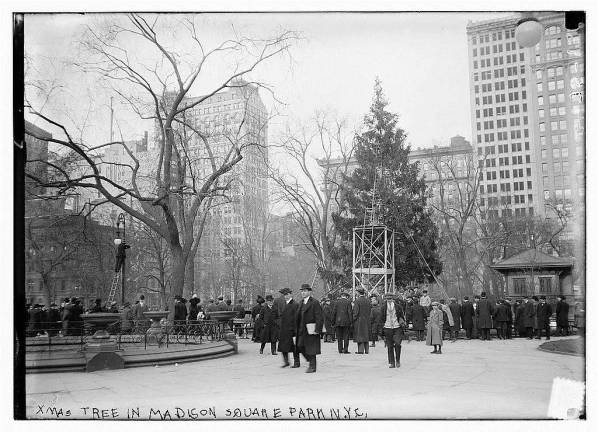New York’s First Christmas Tree Op-Ed

While many New Yorkers might assume that Rockefeller Plaza has always been home to the city’s official tree lighting, for two decades the big event took place about 30 blocks south of 30 Rock, in a gathering that served as a model for the rest of the country.
In December 1912, Madison Square Park played host to New York’s first citywide Christmas tree. The idea of a big outdoor gathering to light up a tree was a novel one — most people celebrating the holiday did so in their homes, and any other large holiday celebrations had generally taken place in churches, bazaars, or theaters.
But in 1912, the city banded together to erect the first truly public tree in the country.
Unlike this year’s celebration, which gives New Yorkers a month to enjoy the evergreen smell and glittering lights, the city’s first tree didn’t light up until Christmas Eve. It was a striking evergreen, sourced from the forests of the Adirondacks and hauled to Madison Square Park. Instead of “Christmas Tree,” this was called the “Tree of Light” in newspapers and in promotions, and with good reason: illuminating it required 2,300 colored electric bulbs (city officials had only planned on 1,300 lights, creating a last-minute scramble as it was being prepared).
On the big day, crowds began gathering in the snow-covered park by early afternoon, with thousands there by the time church bells chimed at 4:50. Finally, as 25,000 New Yorkers pressed together in the park, a call of trumpets announced something the city had never seen before: the lighting of a huge public Christmas tree. As the electric bulbs ignited, including the brilliant “Star of Bethlehem” at the top of the tree, the crowd cheered.
This kicked off a night of singing and music that lasted until midnight, with local choirs and bands performing carols and Christmas standards. The soprano Eva Emmet Wycoff sang “O Holy Night,” and when she finished, the crowd called for an encore, to which Wycoff agreed.
Sausages and coffee were served to the attendees. A group of 200 Boy Scouts helped facilitate the festivities, running messages to the organizers and helping guide the crowd. A band played “The Star Spangled Banner,” continuing on until a midnight performance of “America,” closing out the evening. The lights were shut off shortly after midnight, but the tree would be lit up every evening for the rest of the month, until the final lighting on New Year’s Eve.
The celebration served as a cheery civic gathering, but its goal was also to provide the city’s less fortunate with a place to enjoy the holiday.
“This is a real Christmas for me,” one woman told her friend, according to The New York Times. “Those rich people who give so much money away on Christmas always get the idea that the poor need something to eat. They forget that we also like to look at nice things and hear lovely music.”
The rapturous response to the Tree of Light led immediately to plans for the ceremony to continue the following year.
But it was not just New York City that was excited by the proceedings. The next year, dozens of other cities followed Gotham’s lead. Chicagoans gathered around a commanding 75-foot tree in 1913, lit to the chorus of the city’s Grand Opera Company. Cincinnati introduced a 45-foot-high Christmas tree. Detroit, Baltimore, Jersey City, and about 50 other cities lit up their first municipal Christmas trees in 1913, all following New York’s successful example from the year before.
This community Christmas celebration that originated in New York would spread through press coverage, pamphlets, and instructional books that offered details on how cities could host their own tree lighting. In 1923, President Calvin Coolidge would light up the country’s first National Christmas Tree in President’s Park. But as the grand tree-lighting tradition proliferated, the city that did it first continued to do it biggest. The NYC tree lighting continued for two more decades in Madison Square Park before moving to Rockefeller Center in 1933, where it continues to reign today as the grandest Christmas tree lighting in the country.
Alex Palmer is the author of the new Christmas history book The Santa Claus Man: The Rise and Fall of a Jazz Age Con Man and the Invention of Christmas in New York, out now from Lyons Press.